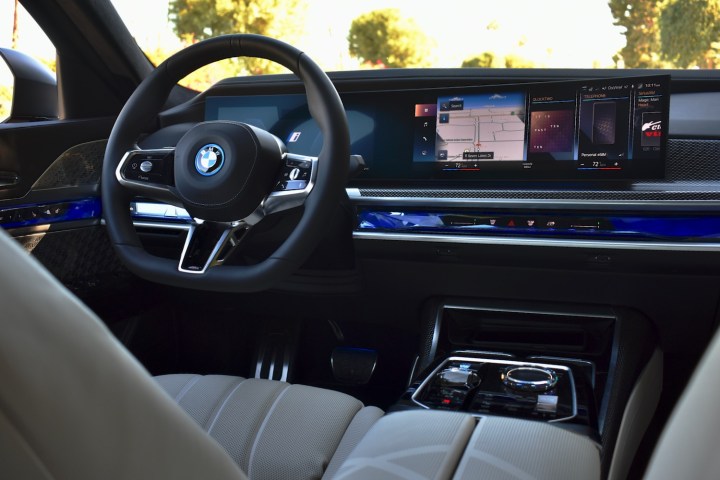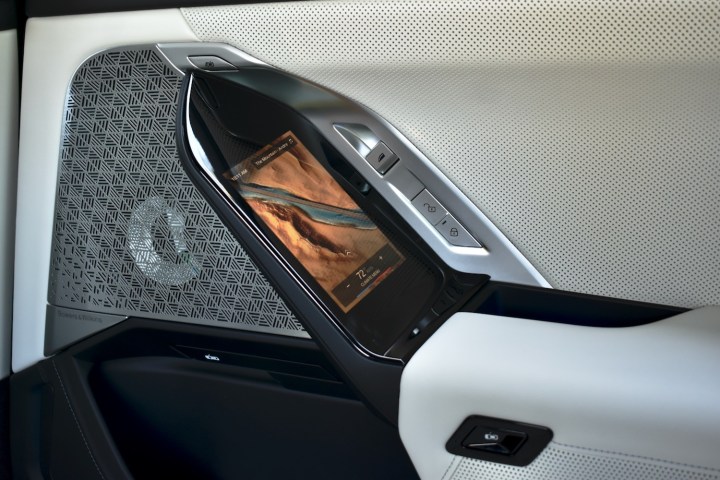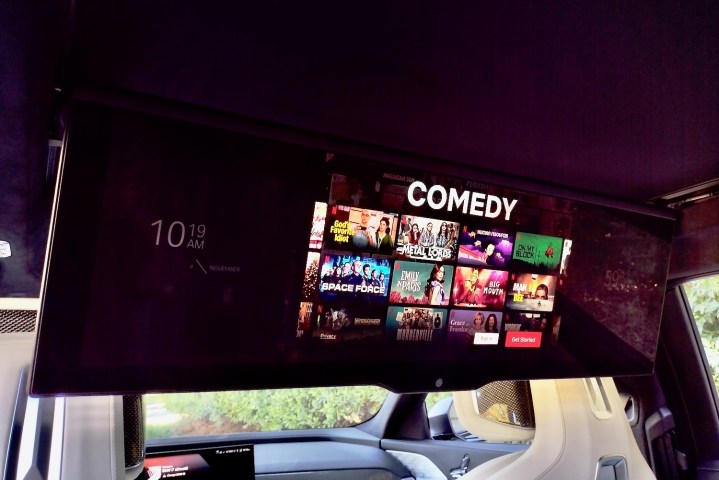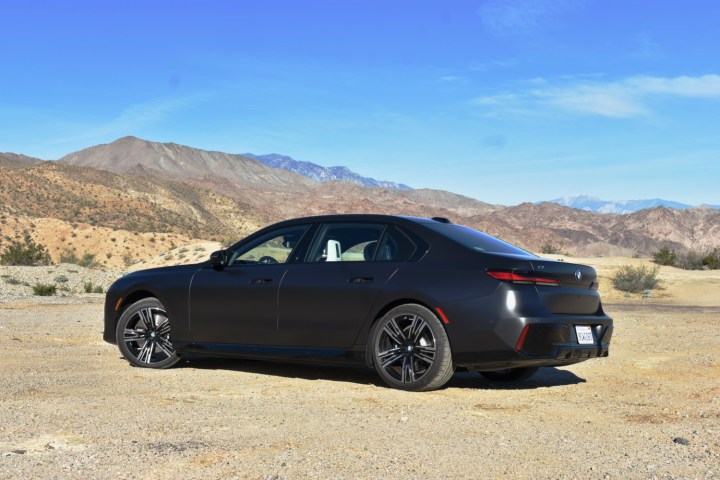The BMW 7 Series has been the venerable German automaker’s flagship for more than 40 years, but with its latest redesign, BMW is taking things in a new — and electrifying — direction.
The 2023 BMW i7 xDrive60 (or i7 for short) is the first all-electric 7 Series in the model’s history. It’s positioned against electric luxury sedans like the Lucid Air, Tesla Model S, and the Mercedes-Benz EQS sedan, a longtime BMW rival. But BMW took a different approach with its electric chariot of the affluent.
Because while those other EVs are based on clean-sheet designs, the i7 is just one version of a car that continues with combustion engines. It shares styling and tech — including an available fold-down, rear-seat widescreen monitor — with internal-combustion 7 Series models. So it offers a more traditional approach to luxury for EV buyers who don’t want to change anything about their cars except the method of propulsion.
Those buyers will also pay a slight premium. The i7 starts at $120,295, compared to $114,595 for the 760i xDrive, the first gasoline 7 Series model of the new generation. BMW also plans to offer a less expensive gasoline 740i for $94,295 sometime after launch. But when you’re spending this much on a new car, those aren’t huge differences.
Design and interior
The new 7 Series — and by extension the i7 — is sure to prove controversial due to BMW’s new front-end styling, which combines a massive grille sure to stoke internet memes and odd-looking two-tiered headlights. The effect is exaggerated by an available blacked-out front-end treatment, which makes it look like parts are missing.
Those styling elements carry over from gasoline 7 Series models to the i7, as does the hulk-like body shell, which is abnormally tall for a sedan, requiring steps at the hood and rear bumper to blend them with the thick center section of the body. The i7 also retains a long protruding hood, which is necessary to house the engine in gasoline 7 Series models, but is just an affectation here.
BMW claims the i7 will appeal to buyers who want a traditional luxury sedan first and an EV second. To be fair, the i7 is much more conventional-looking than the streamlined Mercedes-Benz EQS sedan and Lucid Air, or the grille-less Tesla Model S. But some of that work has been undone by BMW’s unorthodox design choices in other areas, which may not appeal to traditionalists either.
The i7 is sure to prove controversial due to BMW’s new front-end styling.
This design choice does at least yield more rear-seat legroom than the Mercedes EQS sedan and Lucid Air, making the i7 better-suited for chauffeuring rear-seat passengers. Drivers and front passengers won’t notice as much of a difference in space, however.
Like Mercedes, BMW didn’t include a frunk. But where Mercedes made this decision to maximize passenger space, BMW was forced to because the i7’s carryover chassis didn’t allow for it. The i7’s 11.4 cubic feet of trunk space also trails the EQS’ 22.0 cubic feet, and EQS drivers can also fold the rear seats for 63.0 cubic feet of cargo space.
Whatever shortcomings the i7 has in practicality, they’re more than made up for by its gleefully wacky interior. BMW filled it with bizarre light-up crystals, elaborate speaker grilles, and other trim pieces that make the i7’s interior feel different without sacrificing the standards of material quality that should be expected at this price point. BMW offers traditional Merino leather upholstery, but also cashmere wool. And in addition to typical luxury car wood trim, you can have a splash of carbon fiber if you like.
Tech, infotainment, and driver assist
The standard BMW Curved Display interface includes a 12.3-inch instrument cluster and 14.9-inch touchscreen under one piece of glass. Now in its second decade, BMW’s iDrive infotainment system keeps its signature rotary controller, but adds an Interaction Bar with touchpads for climate control and other functions. Also included is 5G connectivity, along with wireless Apple CarPlay and Android Auto.
BMW has already used other versions of the Curved Display setup on the i4 sedan and iX SUV, and the experience is pretty similar here. In fact, we largely ignored the Interaction Bar and instead used the rotary controller and voice recognition most of the time. Those carryover elements worked well in other BMWs and were no different here.
The real party is in the back, though. Knowing that many customers will prefer to be driven rather than drive themselves, BMW embellished the rear seats with their own 5.5-inch door-mounted touchscreens and a trippy illuminated roof. Rear-seat passengers can also make phone calls through the i7’s Bowers & Wilkins surround sound system.
BMW embellished the rear seats with their own 5.5-inch door-mounted touchscreens.
In place of the small individual rear-seat screens most automakers use, BMW offers one giant screen that deploys from the headliner. Dubbed the Theater Screen, it measures 31.3 inches, has 8K resolution, and can show movies, television shows, or video games in 16:9, 21:9, or 32:9 cinemascope aspect ratios. You can also screen content through built-in Amazon Fire TV connectivity. It almost makes us want to leave the i7 plugged in and use it as a very luxurious screening room.
BMW’s Digital Key system lets iPhone users unlock the car and drive without taking their phones out of pockets or bags. It doesn’t work with Android phones, however.
BMW also included the expected array of driver aids, such as automatic emergency braking, forward-collision warning, and adaptive cruise control. Highway Assistant allows for hands-free highway driving at speeds up to 80 mph (drivers must keep their eyes on the road, though), while Parking Assistant Professional lets drivers remotely park the i7, a bit like Hyundai’s Smart Park system. BMW also claims its driver aids will be made more effective by cloud connectivity and higher-quality cameras from Israel’s Mobileye.
Driving experience
BMW installed a dual-motor powertrain producing 536 horsepower and 549 pound-feet of torque, which the automaker estimates will get the i7 from zero to 60 mph in 4.5 seconds and up to an electronically limited top speed of 149 mph.
BMW has teased an M Performance version of the i7, which will be the most powerful 7 Series model, but it remains a tease. For now, the twin-turbo V8 760i xDrive matches the electric model in horsepower, with slightly more torque and a 4.2-second zero-to-60 mph time.
Looking at other EVs, the i7 is slower to 60 mph than the dual-motor Mercedes EQS 580 4Matic sedan, but quicker than the single-motor version. Mercedes also has an AMG performance model on the way, and a Lucid Air or Tesla Model S will decimate the i7 in a drag race.
The i7 a sensory deprivation tank on wheels, not a race car.
The i7 is more about luxury, though. It’s supposed to be a sensory deprivation tank on wheels, not a race car. Interior noise was impressively low, and standard air suspension made every road feel glass-smooth. A soft ride is only part of the equation though; BMW also employed an active roll stabilization system to fight body roll, which can be unsettling for passengers, and a road preview system that anticipates road conditions and automatically tweaks settings to suit conditions.
Befitting BMW’s reputation as a maker of performance cars, the gasoline 7 Series has a reputation for sharper handling and a sportier character than its rivals. That didn’t really translate to the i7, however. While BMW included four-wheel steering to increase agility, the i7 never stopped feeling its size. Every control input seemed filtered through a layer of girth, with something duller and less immediate coming out the other side. It did feel very poised though, so passengers are likely to remain comfortable.
When it comes time to stop, we found the i7 offered higher levels of regenerative braking than other recent BMW EVs. That means you don’t have to rely on the brake pedal as much, although the i7 still falls short of true one-pedal driving. And it defaults to BMW’s adaptive regeneration system, which continuously changes the level of regeneration so you never know exactly how much you’re going to get.
Range, charging, and safety
The i7 is rated at 318 miles of range with 19-inch wheels, 308 miles with 21-inch wheels, and 296 miles with 20-inch wheels. Those are respectable figures for a big luxury car, but also show the shortcomings of BMW’s engineering approach.
The Mercedes EQS sedan is rated at 350 miles in its most-efficient form, while the Tesla Model S and Lucid Air top 400 miles and 500 miles, respectively. All of these cars have similar-sized battery packs, but with its repurposed gasoline-car platform, the i7 only manages an efficiency rating of 89 MPGe combined, compared to 97 MPGe combined for the most-efficient EQS configuration, 120 MPGe for the Model S, and 131 MPGe for the Air.
BMW equips the i7 with an 11-kilowatt AC onboard charger that takes 10.5 hours to recharge the battery pack, and 195-kW DC fast charging that can complete a 10% to 80% charge in 34 minutes, or add 80 miles of driving range in 10 minutes, BMW claims. Owners will also get three years of fast charging at Electrify America stations.
Crash-test ratings from the Insurance Institute for Highway Safety (IIHS) and National Highway Traffic Safety Administration (NHTSA) weren’t available at the time of publication.
BMW’s four-year, 50,000-mile new vehicle warranty carries over to its electric models, which also get an eight-year, 100,000-mile battery warranty.
How DT would configure this car
BMW only offers the i7 in xDrive60 guise, but you’ll need to tack on a few options to its $120,295 base price to get all of the standout tech features.
The Theater Screen is part of a $7,250 Rear Executive Lounge Seating Package, which also includes a reclining rear seat and second-row console. The $6,550 Executive Package includes the active roll stabilization and road preview systems that give the i7 its good ride quality, and it also adds features like front massaging seats and automatic doors.
Two more packages are needed to get the full array of driver aids. The $900 Parking Assistance Package includes the Parking Assistant Professional system, while the $2,100 Driving Assistant Professional Package adds Highway Assistant.
What you get is an electric facsimile of a traditional luxury sedan with some tech gimmicks — namely the Theater Screen and rear-door touchscreens — added on. With its imposing size and old school, long-hood profile, the i7 might be more appealing to current luxury sedan buyers than the Lucid Air, Mercedes-Benz EQS, or Tesla Model S, all of which scoff at tradition.
Those three sedans also surpass the i7 in efficiency and performance, and Mercedes in particular offers similar tech theatrics with the EQS’ massive Hyperscreen front-row display. And while the i7 has the proportions of a traditional luxury sedan, it’s not exactly a conservative design. All of this makes BMW’s decision to package its latest infotainment, powertrain, and chassis tech in a throwback body style puzzling. The i7 is a good car, but it seems to have a very narrow target audience.
Editors' Recommendations
- 2024 BMW i5 unveiled as the first electric 5 Series
- BMW shows off an electric car with color-changing paint at CES 2022
- 2022 BMW i4 first drive review: The real deal
- BMW i4 brings the ultimate driving machine into EV territory
- Watch BMW test an electric jet pack that lets you fly at 186 mph







